Imprints of computing are etched into the surface of the earth. Fugitive traces remain captive in its lithic tissues, its waters, and the very air we breathe. Roiling in the most abyssal depths of the seas, coursing through fiber optic cables thinner than human hairs, the amorphous Cloud and its digital ganglia enshroud our planet. By way of its sheer magnitude and complexity, the Cloud eludes human imagination. It is what Bruno Latour might call a “black box” (1987) – a market fantasy of infinite storage capacity, immateriality, and feel-good “green” slogans like “go paperless.” While envisioned by many to be ether, suspended above matter, the Cloud remains a material ensemble of cables and microchips, computer servers and data centers, electrons and water molecules, cell towers and cell phones, spindly fiber coils undersea and underground that firmly tether communities and consumers to the ground, not the sky.
In this post, I spell out some of the material constraints and embodied effects of cloud computing practices on ecologies and societies to inspire thinking and intervention on the part of scholars, activists, and IT industry insiders.
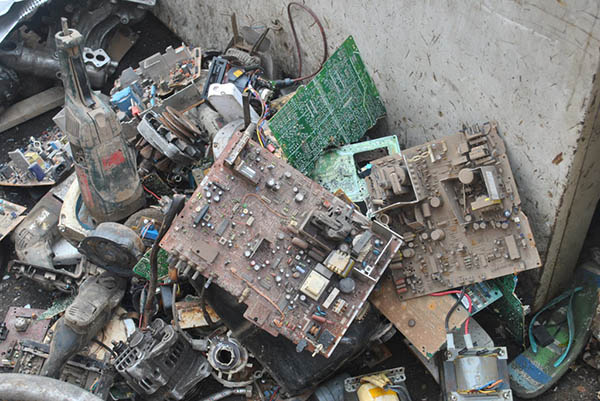
A Computer Graveyard in Agbogbloshie. Photo: Creative Commons.
The Terrestrial Cloud
While the symbol of a benign cumulus cloud can be found in the logo of many cloud companies, an icon of a terrestrial element like fire, water, or lightning would be a far more appropriate index (Durham Peters 2015). From the pooled caloric expenditure of laborers charged with mining the rare earth elements required for the manufacture of computing components, to the titanic siphoning of potable water reserves for the refrigeration of hot electronic components, or in the billions of gigawatts of carbon-sourced electricity consumed by data centers that exceed the energy expenditure of some cities, the Cloud is anything but as traceless as the air, to which it contributes an estimated 2% of annual greenhouse gas emissions.
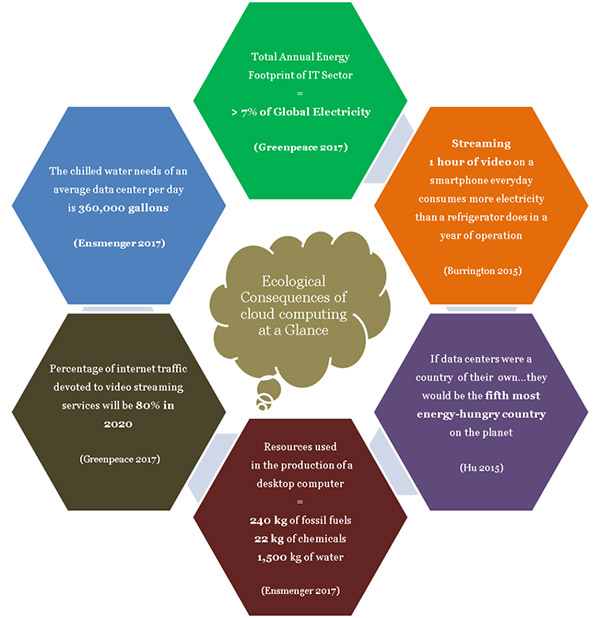
Ecological Impact of Computing. Image: Steven Gonzalez
Given a projected tenfold increase in data center and computing utilization by 2030, continuing to subsume the ecological impact of computing-networked lifeways within the broader paradigms of the Anthropocene may prove especially deleterious to those most vulnerable to its immense and shrouded effects. Consider the child laborers in Agbogbloshie smelting down obsolescent scraps of monitors, phones, and laptops that in turn release toxic gases and chemicals into their bodies and local ecosystems (Ensmenger 2017). Consider the lithium miners who work in abject conditions to harvest the preferred energy source for smart phone batteries, and the capitalist shareholders in the largely unregulated data center marketplace whose commitment to sustainability is only legible in augmented quarterly profits or reductions in total cost of ownership. These ecological parables of the Cloud demand their own analytic to name the forces that mobilize and sustain them, and to responsibly account for the differential lived effects of computing on a planetary scale.
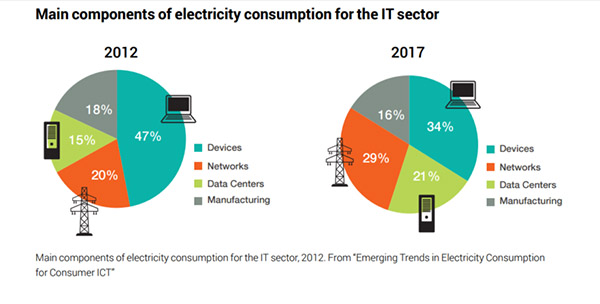
Image: Greenpeace 2017
I contend that it is both practical and politically necessary to address the specific environmental impact of networked computing on ecologies and societies. As an ethnographer of data centers and the IT technicians that manage the energy needs of Cloud infrastructures, I observe firsthand the limits of extant frameworks for making sense of the latent ecological calamity that is the Cloud. We need a new paradigm beyond (or within) the Anthropocene and its troubled rivals (or offspring) to achieve this.
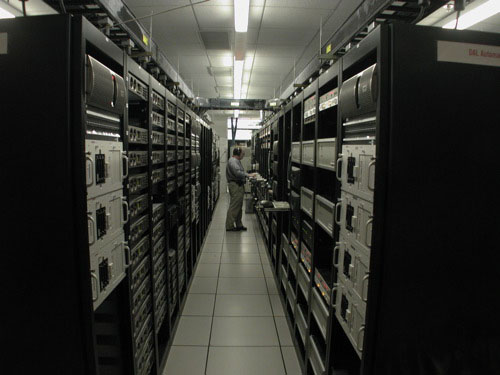
A data center. Photo: Creative Commons.
In the field, I document a range of behaviors and professional norms in North American data centers that contribute to overcooling and energy waste. Ruled by a persistent fear of server outages (which cost companies an average of $9,000 USD per minute according to a recent Ponemon Institute study), it is typical for data center technicians and management teams to eschew energy-efficient practices that are perceived to put server performance at risk. Concurrently, many data center technicians lack sufficient background in thermodynamics and the sociotechnical imaginaries it affords to implement energy-efficient cooling methodologies like active airflow management. While cloud giants like Amazon, Google, and Facebook, have adopted sustainable, efficient designs and practices, a vast cross-section of data center facilities, privately-owned and operated, is run by technicians with limited resources – conceptual and otherwise – to meaningfully reduce the ecological footprint of their facilities. For the stewards of the Cloud, the Anthropocene is realized in customer satisfaction, hot servers made cool at whatever cost, precarious livelihoods and professional performances of competence and infallibility. The servers, themselves objects of a capitalist political economy and agents of ecological transformation in birth, life, and death, may too be figured as drivers of Anthropocene. For all of its capacious affordances, however, the Anthropocene is perhaps too nebulous to bring cloud computing assemblages into heightened relief and scrutiny.
The Cloud at the End of the Holocene
At the turn of the millennium, Paul Crutzen and Eugene Stoermer claimed that a coalescence of ocean acidification, rising sea levels, mass erosion, melting ice caps, pollution, and ubiquitous chicken bones had inaugurated a new geological age called the Anthropocene. Today, scholars in the social sciences, humanities, and natural sciences continue to debate the precision, utility, and political and scientific stakes of the moniker, proposing a range of alternatives.
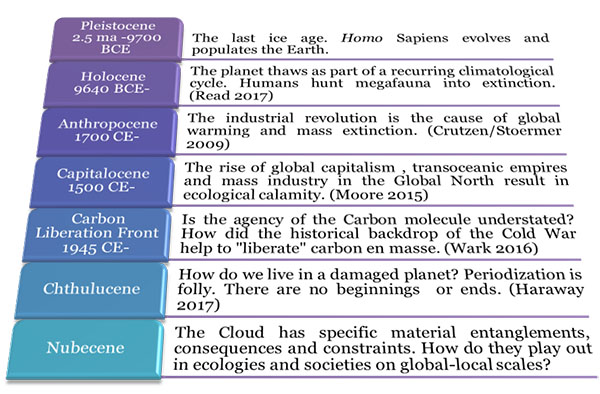
Defining the Nubecene. Image: Steven Gonzalez
Rather than impute an explanatory model that sets out to displace the Anthropocene or its kin, I am instead calling for a parallel genre of description, a heuristic that can apprehend the Cloud and its webbed material-semiotic tendrils in ecologies and societies. To this end I invoke Nubecene, following the Latin root for cloud – nubes – as a descriptor and mobilizing analytic to radically engage with the wide-ranging consequences, promises, and challenges that life under the Cloud precipitates. The Nubecene is a set of narratives about ecological and political entanglements. Its settings range from dangerous lithium mines in the Global South, to the offices of NGOs whose purpose is to bring rural people online for the first time, to subterranean data centers housed within Cold War era bunkers. It even extends to the remote consoles of bitcoin miners, who expend colossal energy to perform cryptography in the pursuit of wealth. Following Vincent Mosco, Nubecene is also a story about how networked engines of cloud infrastructure and pooled computing power are bolstering a newly digital “way of knowing” (2014) known by many as Big Data. My own work seeks to apprehend the behaviors and sociotechnical imaginaries that inform energy management practices within the Cloud, and to identify methods of intervention for scholars, activists, and reformers in the industry.
In the years ahead, I hope to inspire new tales of the Nubecene that take up any of the following themes or phenomena:
- Labor: Mining of rare Earth minerals and metals for the manufacture of computing. Manufacture and assembly of computing components including batteries, semi-conductors, microchips, casings, screens, and molds.
- Infrastructure: Data centers/server farms. Undersea fiber optic cables. Cell towers. Internet exchange centers.
- Energy: Energy footprints in the life cycle of Nubecene objects like servers or smartphones. Carbon toll of everyday cloud services and activities.
- Power: Environmental activism and resistance. Postcolonial entanglements. State policies. Corporate regulation. Surveillance and security. The political geography of servers.
- Culture/Society: The fashioning of neoliberal cloud consumers and the cloud services marketplace. How Nubecene objects shape daily life. Digital worlds and their material basis. Gender and identity online. Big Data/ “Digital Positivism”.
- Ecologies: Toxicity in computer graveyards. Biome ruptures following cloud infrastructure construction. Neurophysiological consequences of sustained use of Nubecene
References
Ensmenger, Nathan
2017 The Environmental History of Computing. School of Informatics & Computing. Indiana University
Haraway, Donna.
2015 Staying with the Trouble: Making Kin in the Chthulucene. Duke University Press: London.
Latour, Bruno
1987. “Introduction: Opening Pandora’s Black Box.” In Science in Action: How to Follow Scientists and
Engineers through Society, 1-21. Cambridge, MA: Harvard University Press.
Mosco, Vincent.
2015. To the cloud: Big data in a turbulent world: Routledge.
Peters, John Durham
2015 The Marvelous Clouds. University of Chicago Press. Chicago.
